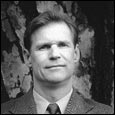Staff Profile: Landscape Architect Jim Horner
By Julia Sommer, Public Affairs
Posted March 31, 1999
 Jim Horner. Peg Skorpinski photo. |
While Horner may be particularly interested in trees -- he was a landscape architect for the U.S. Forest Service for 13 years -- he is also intimately aware, it seems, of every bush, sculpture, bench, hand-railing, pathway, stairway, light, bike rack and, most especially, construction site on campus. The "collateral damage" the latter inflict is one of his constant concerns.
Horner was appointed campus landscape architect in the Department of Planning, Design and Construction in 1996. "It's the pinnacle, the culmination of my career," he says. "I've wanted this job for a long time. It's a demanding but rewarding position that draws on all facets of my education and professional experience."
Horner graduated from Berkeley with a major in landscape architecture in 1971, a year ahead of Berkeley's former landscape architect, Ortha Zebroski.
His Berkeley roots date back to 1913, when his grandmother moved her family from Arizona to the corner of Hearst and Le Conte streets. (The house burned down in the 1923 fire.) His father, uncles, aunts and brother all graduated from Berkeley. His daughter hopes to transfer to Cal next year.
Growing up in Berkeley, the campus was Horner's park. "During the anti-war riots, I felt like people were trashing my living room," he recalls.
Today, Horner's deep love for the place is palpable.
His first major project was completion of Memorial Glade -- a trial by fire, what with El Nino and a challenging review process.A more recent project is the transformation of the Center Street entrance to campus and the adjacent Grinnell Natural area, including new pathways, bikeways, lighting, emergency phones, signage and planting. The Class of '53 is well on its way to raising $250,000 for a suitable marker for this western entrance.
Once Haas Pavilion is completed, Horner points out, this "more generous front door" to campus will allow crowds from the downtown Berkeley BART station to reach games or the center of campus quickly, safely and pleasantly.
Passing an unkempt Daily Cal news rack, Horner notes that a company has offered to replace them in exchange for advertising space.
"We're trying to hold the line on advertising," he says quietly. "The campus would lose a lot of its dignity and character as a park-like setting if we let it in."
Horner's major project at the moment is the $3.4 million renovation of Edwards Stadium. "It's exciting to be part of the transformation of this historic venue into a world-class facility for both track and field and soccer," he says.
Continuing his guided tour through campus, Horner notes that many campus trees have been lost over the past 30 years, mainly to construction but also to storms and old age.
"Mature trees are an important character element," he says. "They are part of what makes this campus so distinctive." Berkeley has several rare tree species, says Horner, such as the Mongolian oak at the Oxford tract. He is looking for a very special tree to plant on campus in memory of Malcolm Hart, the student killed by a Donner Pass avalanche this winter. Hart's friends are raising money for the project.
As consultant on every aspect of the campus landscape, Horner advises or serves on committees concerned with landscape guidelines, disabled access, bikes, Strawberry Creek, signage, lighting and outdoor art.
After graduating from Berkeley, Horner became forest landscape architect for Stanislaus and then Lassen National Forest. For one year, on an exchange with the National Park Service, he was Yosemite's landscape architect.
"After Reagan became president, resource management and funding went downhill, so I came back to Berkeley to work in private practice," says Horner. "Public service was a great experience and a good foundation for my job here in terms of politics and visibility."
After leaving the Forest Service, Horner worked for 12 years with two Bay Area landscape architectural firms doing corporate campus and public works projects.
Finishing up his tour of campus, Horner points longingly at the trailers in Wellman Courtyard.
"John Galen Howard planned a formal garden for that area," he says. "I'd like to see it become a sculpture garden."
With the campus landscape in such caring hands, that might just happen.
![]()
![]()
March 31 - April 6, 1999 (Volume 27, Number 28)
Copyright 1999, The Regents of the University of California.
Produced and maintained by the Office of Public Affairs at UC Berkeley.
Comments? E-mail berkeleyan@pa.urel.berkeley.edu.